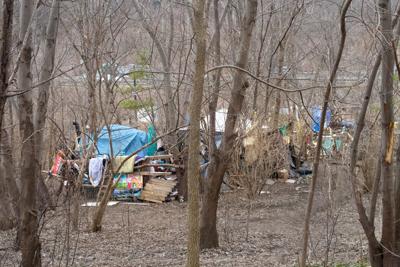É«É«À² has seen a dramatic increase in homelessness, according to a new city survey that recorded more than 15,000 residents without housing.
The point-in-time review, called the street needs assessment, looks to capture the scope of homelessness across shelters, encampments, hotel programs, respites, health-care and correctional facilities.
The most recent survey, performed last fall,  Monday as part of the agenda for the city’s economic and community development committee.
It showed that an estimated 15,418 people were experiencing homelessness in É«É«À² on Oct. 23, 2024. It was done by counting and surveying the number of people experiencing homelessness on that one night.
The previous survey found 7,347 people experiencing homelessness in 2021 (possibly an undercount, due to pandemic restrictions), and 8,715 in 2018. The survey is performed every few years.
These numbers are “horrifying but sadly unsurprising,” said community worker Diana Chan McNally, who was not involved with the survey. “And that is likely an undercount. Shelters remain full, and encampments and unsheltered homelessness are growing.”
The report noted that pressures in the shelter system the night of the count were complicated by a delay in the city’s allocation of the Canada-Ontario Housing Benefit (COHB) between April and October 2024.
It’s also imperfect, as outreach teams may not reach some more remote encampments, and the survey cannot comprehensively capture what’s known as “hidden homelessness” — a term that refers to individuals or families who may be couch-surfing or staying temporarily in precarious arrangements rather than on the streets.
Chan McNally noted the count wasn’t as thorough in 2021, due to the challenges of collecting data in the pandemic, and it makes more sense to compare to 2018.
The 2021 survey was a picture of a city still restricted by pandemic rules, with more temporary hotel shelters in operation and border restrictions that limited the flow of refugees/asylum claimants. It was also conducted in the spring and 2024’s survey was conducted in the fall.
Compared to 2018, the new figures are a 77 per cent increase in the city’s homeless population over six years.Â
City staff declined an interview on the report and referred to a news release on the numbers in the street needs assessment.
“The city is already seeing a reduction in these numbers, attributable to the decrease in refugee claimants in shelters, lower encampment numbers across the city and movement of people into permanent housing,” said a release from media relations.
The 2024 survey includes 6,350 refugees and 1,615 people staying outdoors, including in encampments. It also includes 2,664 people in “city administered sites — bridging and triaging programs,” that aren’t listed in data for previous years and it’s not clear if they are new people being counted or if they are just categorized differently.Â
As with past assessments, the survey respondents reported the leading cause of homelessness to be not enough housing, and 22 per cent of respondents said eviction was the reason for their most recent loss of a home.
Almost two thirds of people who responded said they had multiple health challenges, primarily mental health issues and substance use.Â
“Results show homelessness in É«É«À² has increased since 2021 as result of a wide range of issues such as lack of affordable housing, unmet health needs, insufficient income support and substance use struggles. This mirrors trends seen in Ontario and across Canada,” the city’s release added.Â
That was a sentiment echoed by Chan McNally, who said there are a number of reasons why homelessness is rising, but affordability is at the forefront, and it’s a provincewide problem.
“Rents are skyrocketing and affordable housing is increasingly scarce. Wages and social assistance are disconnected from the cost of living. Unemployment is growing,” she said.Â
The city is forced to fill in the gaps, but is limited in what it can do “without significant change in provincial policy.”
Indigenous people, racialized groups, Black communities, and 2SLGBTQ+ communities continue to be overrepresented in the 2024 snapshot. This was a trend seen in past surveys.
“The scope of the homelessness crisis requires thoughtful, strategic responses. The City is focused on building new homes and shelters, bolstering support programs and reinforcing strong intergovernmental funding partnerships to address these challenges,” the report said.
The city’s will discuss the findings of the street needs assessment on July 9.Â
With files from Victoria Gibson






























To join the conversation set a first and last name in your user profile.
Sign in or register for free to join the Conversation